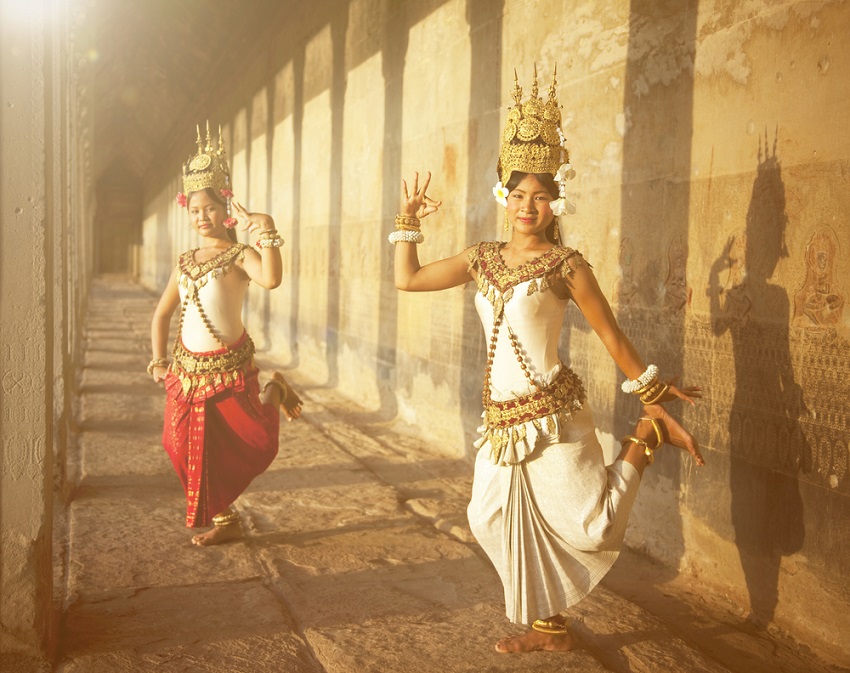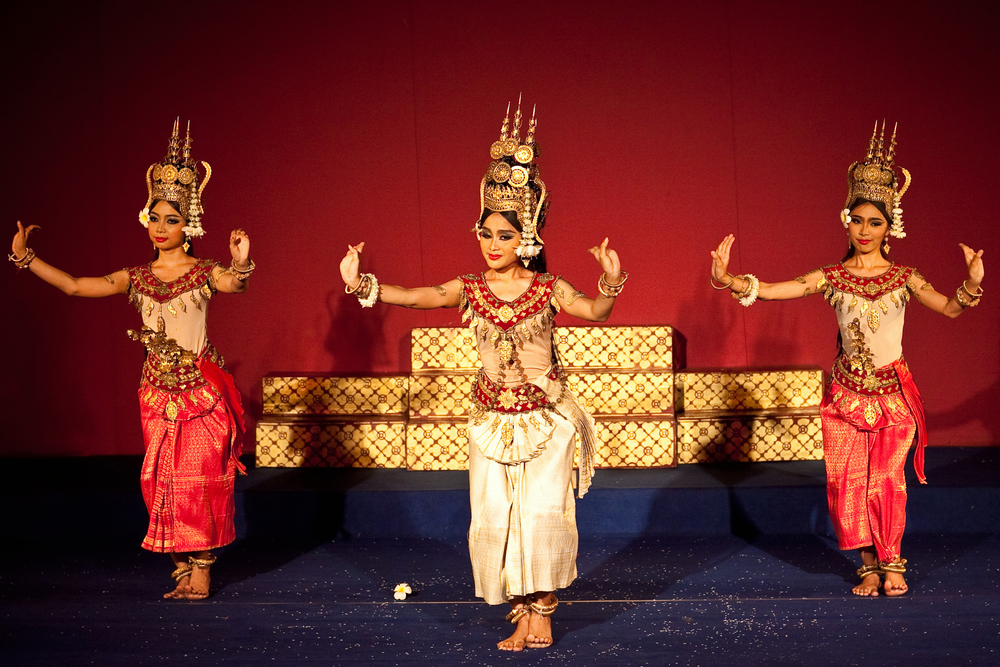Cambodia - performing arts
Cambodian arts and performances have had so much to contribute to cultural inheritance commonly shared by many countries in Southeast Asia. Gestures of dance appeared on petroglyphs at Angkor Wat have been so unique that they inspired the alluring dance of Apsara. Having been transformed into Cambodian modern dancing arts, it is unclear how the dancing arts in Cambodia were created. However, much speculation presumed the arts had been created since Nakhon Phnom era during 1-6th century. Chaiwat Saothong points that ‘Cambodian dancing arts came into light in Angkor era (540-800). Clay figures in Angkor Burei era, for example, make gestures of dance as well as Khmer language inscriptions that mentioned about ‘dancers’.Pani, a Sanskrit word belonging to Angkor era (825-1400), means acting and storytelling. If we review several petroglyphs in Khmer stone castles, it is no doubt Khmer Empire had its own dances and performances. Those were common forms of entertainments for both court and subjects. The inscriptions mentioning about priests posted at religious places indicate that there might have been ‘dancers’ staying with the priests too. Ancient Cambodian dancing arts were basically influenced by India, and have been developed as much flourished as other arts and sciences.’ (ชัยวัฒน์ เสาทอง, 2548:40)
The leading figure having given so much contribution to Cambodian modern dancing arts is Preah Mahaksatriyani Sisowath Monivong Kossamak Nearirath Serey Vathana, a mother of Narodom Sihanouk. She is respected as the mother of Cambodian modern dancing arts according to Khmer Dance book. It is translated from Khmer Language reading that ‘she made a supreme sacrifice putting countless efforts and donations to support research and studies to made sure that the arts could be documented and uplift Cambodian culture.’ (เพชร ตุมกระวิล, 2548)Moreover, she initiated Apsara Dance, the ancient Khmer dance, in which princess Narodom Buppha Devi, one of Narom Sihanouk’s daughters, was chosen to be the first Apsara of Cambodia.Apsara Dance significantly contributed to Cambodian struggle for independence from France in a way that Narodom Sihanouk introduced the dance to the world embarking on a world tour with an aim at showing a glimpse of those glorious days of Angkor Wat. The show was travelling to Europe and North America to gain independence from France (สุจิตต์ วงษ์เทศ, 2556).
At the present, a ballet type of Cambodian dancing arts can be categorized into three groups.
- Ancient Khmer Ballet is a court dance such as Apsara Dance, Robam Tep Monoram, Robam Chon Pol,Robam Monimekkha andRobam Sovann Maccha (เพชร ตุมกระวิล, 2548).
- Traditional Khmer Ballet is featured in traditional events such as Robam Kauangrae, Robum Nesart, Robam Sanpol, Robam Trut, Robam Neongmael, Robam beakrovan, Robam ka-ngag pailin, Robam krobei perngsara and Robam Kantaerae(เพชร ตุมกระวิล, 2548).
- The joyous Khmer people’s Ballet is a folk ballet such as Rumwong Bhumtamoi (เพชร ตุมกระวิล, 2548).
Plunging into turmoil under the Khmer Rouge regime from 1975-1979, Cambodia saw its dancing arts including other forms of arts destroyed. Male dancers called ‘Silpakorn’ and female dancers called ‘Silpakini’ were killed since they had been believed to be feudal inheritance. However, if some happened to be favored by the Khmer Rouge, they could live and perform what the Khmer Rouge wanted to watch. After the country became more stabilized in 1993, the dancing arts including Ancient Khmer Ballet were continued. The Apsara Dance has been popular until now (เพชร ตุมกระวิล, 2548).
Bibliography
เพชร ตุมกระวิล. (2548). ระบาขแมร์. บุรีรัมย์: โรงพิมพ์วินัย.
ชัยวัฒน์ เสาทอง. (1 พฤษภาคม 2548). นาฏศิลป์กัมพูชา. ศิลปวัฒนธรรม, 26(7), 40-44.
สุจิตต์ วงษ์เทศ. (5 พฤศจิกายน 2556). นาฏศิลป์กัมพูชากับไทย: สุจิตต์ วงษ์เทศ. เรียกใช้เมื่อ 26 กันยายน 2559 จาก เว็บไซต์ทางอีศาน: http://e-shann.com/?p=4917





